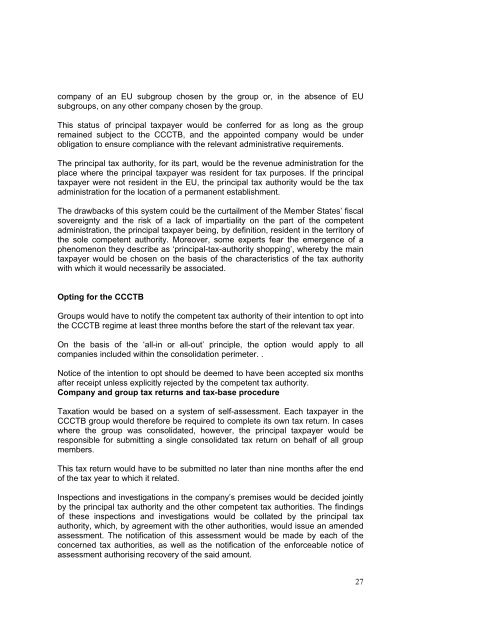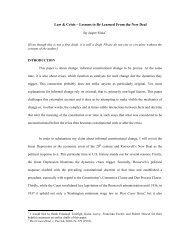An outline of the CCCTB (Common Consolidated Corporate Tax ...
An outline of the CCCTB (Common Consolidated Corporate Tax ...
An outline of the CCCTB (Common Consolidated Corporate Tax ...
You also want an ePaper? Increase the reach of your titles
YUMPU automatically turns print PDFs into web optimized ePapers that Google loves.
company <strong>of</strong> an EU subgroup chosen by <strong>the</strong> group or, in <strong>the</strong> absence <strong>of</strong> EU<br />
subgroups, on any o<strong>the</strong>r company chosen by <strong>the</strong> group.<br />
This status <strong>of</strong> principal taxpayer would be conferred for as long as <strong>the</strong> group<br />
remained subject to <strong>the</strong> <strong>CCCTB</strong>, and <strong>the</strong> appointed company would be under<br />
obligation to ensure compliance with <strong>the</strong> relevant administrative requirements.<br />
The principal tax authority, for its part, would be <strong>the</strong> revenue administration for <strong>the</strong><br />
place where <strong>the</strong> principal taxpayer was resident for tax purposes. If <strong>the</strong> principal<br />
taxpayer were not resident in <strong>the</strong> EU, <strong>the</strong> principal tax authority would be <strong>the</strong> tax<br />
administration for <strong>the</strong> location <strong>of</strong> a permanent establishment.<br />
The drawbacks <strong>of</strong> this system could be <strong>the</strong> curtailment <strong>of</strong> <strong>the</strong> Member States’ fiscal<br />
sovereignty and <strong>the</strong> risk <strong>of</strong> a lack <strong>of</strong> impartiality on <strong>the</strong> part <strong>of</strong> <strong>the</strong> competent<br />
administration, <strong>the</strong> principal taxpayer being, by definition, resident in <strong>the</strong> territory <strong>of</strong><br />
<strong>the</strong> sole competent authority. Moreover, some experts fear <strong>the</strong> emergence <strong>of</strong> a<br />
phenomenon <strong>the</strong>y describe as ‘principal-tax-authority shopping’, whereby <strong>the</strong> main<br />
taxpayer would be chosen on <strong>the</strong> basis <strong>of</strong> <strong>the</strong> characteristics <strong>of</strong> <strong>the</strong> tax authority<br />
with which it would necessarily be associated.<br />
Opting for <strong>the</strong> <strong>CCCTB</strong><br />
Groups would have to notify <strong>the</strong> competent tax authority <strong>of</strong> <strong>the</strong>ir intention to opt into<br />
<strong>the</strong> <strong>CCCTB</strong> regime at least three months before <strong>the</strong> start <strong>of</strong> <strong>the</strong> relevant tax year.<br />
On <strong>the</strong> basis <strong>of</strong> <strong>the</strong> ‘all-in or all-out’ principle, <strong>the</strong> option would apply to all<br />
companies included within <strong>the</strong> consolidation perimeter. .<br />
Notice <strong>of</strong> <strong>the</strong> intention to opt should be deemed to have been accepted six months<br />
after receipt unless explicitly rejected by <strong>the</strong> competent tax authority.<br />
Company and group tax returns and tax-base procedure<br />
<strong>Tax</strong>ation would be based on a system <strong>of</strong> self-assessment. Each taxpayer in <strong>the</strong><br />
<strong>CCCTB</strong> group would <strong>the</strong>refore be required to complete its own tax return. In cases<br />
where <strong>the</strong> group was consolidated, however, <strong>the</strong> principal taxpayer would be<br />
responsible for submitting a single consolidated tax return on behalf <strong>of</strong> all group<br />
members.<br />
This tax return would have to be submitted no later than nine months after <strong>the</strong> end<br />
<strong>of</strong> <strong>the</strong> tax year to which it related.<br />
Inspections and investigations in <strong>the</strong> company’s premises would be decided jointly<br />
by <strong>the</strong> principal tax authority and <strong>the</strong> o<strong>the</strong>r competent tax authorities. The findings<br />
<strong>of</strong> <strong>the</strong>se inspections and investigations would be collated by <strong>the</strong> principal tax<br />
authority, which, by agreement with <strong>the</strong> o<strong>the</strong>r authorities, would issue an amended<br />
assessment. The notification <strong>of</strong> this assessment would be made by each <strong>of</strong> <strong>the</strong><br />
concerned tax authorities, as well as <strong>the</strong> notification <strong>of</strong> <strong>the</strong> enforceable notice <strong>of</strong><br />
assessment authorising recovery <strong>of</strong> <strong>the</strong> said amount.<br />
27
















